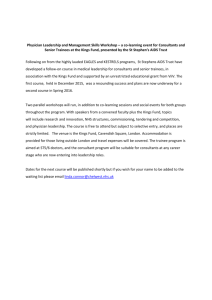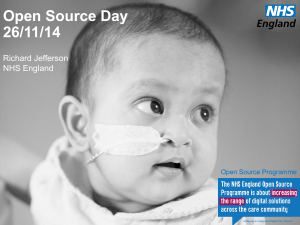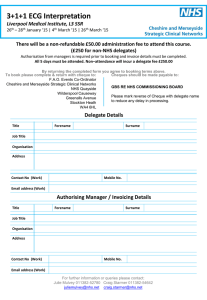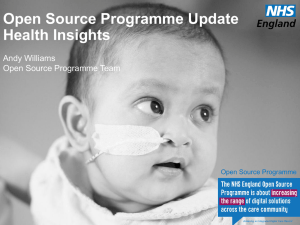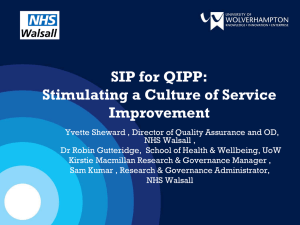Leadership Development
advertisement
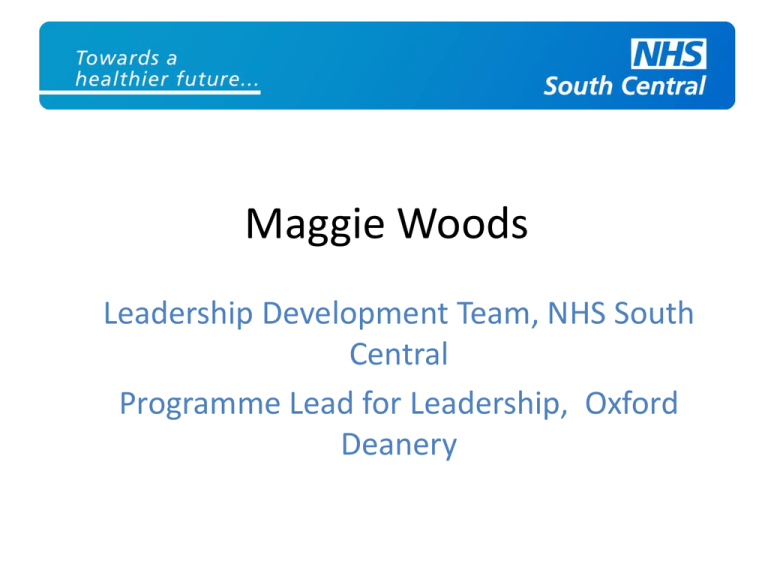
Maggie Woods Leadership Development Team, NHS South Central Programme Lead for Leadership, Oxford Deanery What we will cover today • • • • • • Context Leadership Teamwork and leadership Leadership and change Two approaches to leadership So what? • The NHS sees I million patients every 36 hours, spending 2 billion a week. • The number of managers is 3.6 % of the workforce Source Kings Fund 2011 4 % patients diagnosed with dementia whose care has been reviewed in the last 15 months, 200910 5 The number of people aged 85+ in this country will double in the next 20 years 6 7 Constants • Clinical Engagement, GP commissioning • Relationship with patients, shared decision making • Outcome focused to drive delivery • Independent sector, voluntary and private, • QIPP challenge Lets talk Leadership……… Leadership is the art of motivating a group of people to achieve a common goal Kings Fund May 2011 The function of leadership is to add value The NHS Leadership Framework • It includes 5 core dimensions, drawn from the MLCF/CLCF: – – – – – Demonstrating Personal Qualities Working with Others Managing Services Improving Services Setting Direction • There are two additional dimensions – Creating the vision – Delivering the strategy 12 Management Matters! Kings Fund May 2011 Interesting Reading • Kings Fund report; May 2011 http://www.kingsfund.org.uk/publications/nhs_leadership.html • The conclusions challenge some of the negative attitudes towards managers, and questions current plans for major reductions in management and administration costs. • The commission believes that the NHS needs to move beyond the outdated model of heroic leadership to recognise the value of leadership that is shared, distributed and adaptive. • In the new model, leaders must focus on systems of care and not just institutions and on engaging staff in delivering results. PEOPLE + Outcomes, Activities, Behaviours RESOURCES KNOWLEDGE SKILLS ABILITIES VARIABLES LEADERSHIP/ MANAGEMENT ACHIEVE VISION Poor leadership has a cost, Francis – what he identified: • Preventable deaths • insufficient attention to professional standards • a weak professional voice in management decisions • acceptance of poor standards of conduct • low staff morale - demoralised • a lack of any systematic approach to coordinating care • very poor communication Team Working and Leadership 110 108 106 104 102 100 98 96 94 92 90 % Staff Working in Teams The link between the Management of People & Patient Mortality in Acute Hospitals West M et al. Int J HR Management 2002 13:8 1299-1310 “Don’t tell people how to do it, tell them what to do and wait for the results” General Patton Employee Engagement (NHS Staff Survey Findings) Performance Appraisal Team Working Job Design Supervisors’ Support Work Pressure Having an interesting job Feeling valued by colleagues Employee Reactions Overall Engagement Health and Well-being Stress Presenteeism Advocacy Hospital Performance Intrinsic Engagement Quality of Services Involvement Financial Performance Absenteeism Patient Mortality Rate client Satisfaction Benefits of Team Working • • • • • • • Reduced hospitalisation and associated costs Improved service provision Improved levels of innovation in patient care Reduced error rates Lower patient mortality Enhanced patient satisfaction Increased staff motivation and mental well-being West, M.A. & Borrill, C.S. (2005). The Influence of Team Working. In Cox, J., King, J., Hutchinson, A. & McAvoy, P. (eds). Understanding Doctors’ Performance. Oxford: Radcliffe Publishing. Team functioning and patient satisfaction 3.3 3.2 Patient experiences 3.1 Clarity of objectives 3 Reflexivity Support for innovation 2.9 2.8 2.7 Low Moderate Team functioning High Staff absenteeism • • 5% more staff working in real teams associated with 0.27% in overall absenteeism rate (p < .001) For an “average” acute hospital, this represents a potential estimated saving of over £1 million per year in direct salary alone Questions for you? • Does your team have clear goals/ objectives? • Who is in your team? • Do you have regular 121s and feedback mechanisms? Leadership and Change Management Change as a Human Process DENIAL Anger Self Esteem or Morale Shock COMMITMENT Internalising Realisation FUTURE PAST Depression Search for meaning Testing RESISTANCE Acceptance & letting go EXPLORATION Time Adapted from Adams, Hayes and Hopson : Transition, understanding and managing personal change; 1976 • Future, Engage , Deliver, Steve Radcliffe • Good To Great, Jim Collins •Future •Engage •Deliver Help people see the future, create a future that is compelling, makes best use of their skills. Move from the present. Engage with people: open & honest conversations. Feedback Maintain a healthy emotional bank account. Listen and hear. Be present. Autonomy. Cross sectors/ boundaries Mobilise the team’s drive for improvement, provide a sense of purpose, hold people to account, drive for results and celebrate success so people feel they have done something important . Make things happen Good to Great, Level 5 Leaders • All good to great companies had level Five leaders • Level 5 = personal humility and professional will • Modest and safe effacing, motivated to produce sustainable results, plough horses • Level 5 leaders; look out the window to attribute success, in the mirror when things go wrong • Many people have the potential to be level five leaders • Most level five leaders come from within their companies • Level five leaders, get the right people on the bus… and the wrong people off the bus, and then figured out where to drive it • When in doubt…..don’t hire - keep looking • When you need to make people change- act • Put your best people on your biggest opportunities, not your problems Create a climate.. • Lead with questions…not answers • Engage in dialog and debate not coercion • Conduct investigations without blame • Build red flag mechanisms to identify essential information that cannot be ignored What actions do you need to take to become the leader that you aspire to be? Thank you maggie.woods@southcentral.nhs.uk



